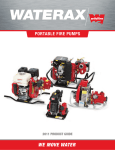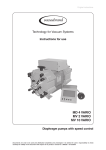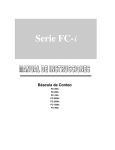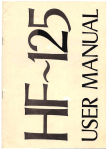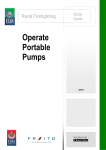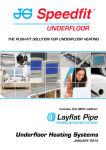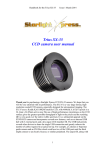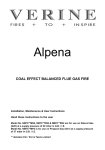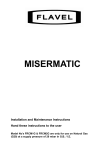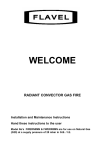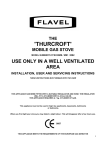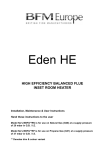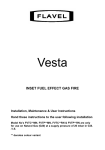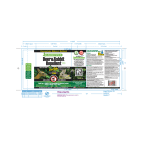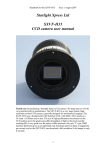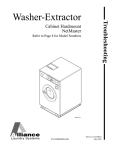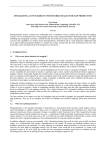Download Rural Fire Appliance Medium Ops manual 2010
Transcript
MEDIUM RURAL FIRE APPLIANCE USER MANUAL 2010/11 Ltd Contents Section Page 1. General 5 2. Pump Operation 6 3. Operating Controls 7 4. Tank Refill 13 5. Hose Winder 14 6. Electrical Equipment 15 7. Brush Bar 21 8. Tie down Eyes 21 9. Important Notes 21 10. Pump Maintenance instructions 22 11. Appliance Maintenance Instructions 23 12. Contacts 24 2 3 Addendum Pump maintenance Instructions Engine operating instructions Aquafoam operating instructions Aquafoam fitting instructions Electrical schematics 4 1. General The Isuzu NPS 300 Medium Rural Fire Appliance is specifically designed for New Zealand Rural Fire Service and is suitable for providing fire protection in forest and rural areas. As such the appliance is constructed from rugged materials on an Isuzu 4x4 cab chassis. The 1800 litre water tank is constructed from fabricated polymer and is designed to be light and durable and is flexibly mounted on a flat lightweight steel deck. The Tyco BB4 multistage high pressure pump is powered by a Briggs and Stratton 4 stroke air cooled v twin engine and the whole unit is fitted to the deck using anti vibration mounts. Along with the pump is a 12v battery connected to a charging system to operate the electric starter, and a removable fuel tank with a fire protection cover and manual fuel primer. Supplied are two 4 metre lengths of 50mm suction hose with 50mm camlock couplings. The manual rewind hose reel is fitted with 50m of 19mm high pressure hose with a 25mm adjustable reel branch. 5 2. Pump operation Ensure that the pump engine has been filled with the correct grade of oil to the proper level on the dipstick. Ensure that the separate fuel tank is filled with unleaded petrol of a rating of 86 octane. Ensure that that there is sufficient water in the tank and that the pump does not run dry as this will ruin the pump seal. Starting Pump Open the pump inlet valve so that the handle is facing towards the water tank. Close all valves on the manifold and open the grey 25mm primer valve on the right hand side (item 5, Fig 3) Pump the handle on the primer pump until water is discharged from the outlet pipe onto the ground below the deck. Close the primer valve (5) Do not try to operate the primer with the valve closed as this will damage the primer membrane Prime the fuel line using the manual bladder pump. Move choke control to CHOKE or START Move throttle to quarter open position Move toggle switch to ON position and press START button Running Allow the engine to warm up at low speed until it runs smoothly with the water at a constant flow before increasing the pump pressure. Open one of the green forestry delivery valves slowly and allow the layflat hose to fill with water before increasing the throttle. Run the pump with the pressure gauge needle in the green range. Stopping When the pumping operation has finished, close the 10mm ball valve on the foam inlet (Item 4, Fig 3) and turn the Aquafoam controller to the OFF position. Run the pump for a few minutes until all the residual foam has been cleared from the pump and hoses. 6 3. Operating Controls L Port valve Fig 1 Supply from Tank Fig 2 Supply from Open Water A 50mm 3 way L-port valve is fitted to the pump inlet in order to use the pump from either the tank or an external source. (draughting from open water) When the handle of the valve is pointed towards the pump this allows water to be drawn into the pump from a river or stream using the supplied suction hose and strainer which can be fitted to the camlock coupling on the valve. Turning the valve handle to face the tank opens the flow of water from the tank. 7 Outlet Manifold 1 2 3 3 6 7 4 5 8 Fig 3. Manifold The outlet controls are all operated from a central manifold located at the rear of the vehicle and are all manually operated: 1. 2. 3. 4. 5. 6. 7. 8. Outlet to hose reel (Yellow handle) Tank fill (Black handle) Manifold inlet Foam controller supply & filter (Red handle) Primer outlet (Grey handle) Forestry coupling outlet No 1 Forestry coupling outlet No 2 (Green handles) Forestry coupling outlet No 3 8 Hose reel Fig 4. Hose Reel To operate the hose reel pull out the locking pin and twist half a turn to lock open. Pull out hose (caution – hose reels out freely) Turn on hose reel supply valve (Yellow handle) on pump manifold Hose reel operating pressure is within the yellow band on the pump pressure gauge. NOTE: do not exceed 2,000 Kpa After winding in the hose replace nozzle into recess and lock drum Grease hose reel bearings at 3 monthly service. 9 Foam proportioning system Introduction The Aquafoam Fire Fighting Foam Proportioning System is a round the pump, venturi fed induction system for accurately metering fire fighting foam concentrate directly into the pump. The unit is suitable for both Class A (0.1% - 1.0%) and Class B (3% - 6%) foams. The foam unit is backlit which activates with the vehicle park lights. There are no light bulbs in the system and the light is generated electronically. Do not attempt to dismantle this unit as there are no serviceable components inside. Operators should be aware that if delivery nozzles are shut down for any prolonged period, the metering valve on the Control Unit should be set to the OFF position. This is necessary to prevent the foam solution from being drawn into the system during the shut down period. Whilst the amount of foam concentrate used during the period of shut down is minimal, it is good policy to adopt this procedure at all times. Delivery nozzles should be opened regularly to allow the foam solution to flow for a short period, to ensure that cavitation of the pump does not occur. Failure to do this will result in damage to the pump and valves. 10 Operating Foam System Start pump as per section 2 of this manual (Pump Operation) and supply water through either the hose reel or a forestry hose outlet. Fig 5. Foam proportioning control Set Aquafoam control at 1.0% (full strength) as this will feed the foam through more quickly. Turn on the foam inlet valve (Item 4,Fig 3). The red handle on the right rear of the manifold. Turn on the valve (small red lever) under the pump inlet pipework. Run the system until foam shows at the nozzle. Adjust foam ratio to the desired rate 11 Foam application ratio Application Foam ratio Mop up 0.1% Initial suppression 0.5% Back burning 0.5% Exposure protection 1% Structural attack 1% Shutting down foam system Turn Aquafoam control to „OFF‟ Run pump until hose line flows water only Close both foam inlet valves. Important: Foam must be flushed from system after use 12 4. Tank Refill Fig 6. Tank filling valve The tank can be filled from a hydrant or another pump while the appliance pump is operating via a 70mm instantaneous coupling which is mounted on the rear of the nearside mudguard. This coupling is fitted with a 50mm ball valve to control the inlet flow and a check valve to prevent the tank from emptying should the valve be left open. The removable strainer fitted to this coupling should be regularly removed and cleaned Ensure that the tank filling valve (Fig 6) is always opened and closed slowly to avoid water hammer and undue pressurisation of the water tank and pipework. The tank can also be self filled by the appliance pump. Connect the suction hose and strainer to the rear facing camlock coupling on the L Port valve and open the valve so that the lever is pointing towards the pump. Ensure that both foam induction valves are closed (red handle valves on manifold and pump inlet) Prime pump as per instructions in section 2.3 Start pump Open the tank fill ball valve with the black handle (Item 2, Fig 3) until the tank is full. Do not open this valve directly after foam has been used as this will result in foam entering the tank. Always flush clean water through the pump first. 13 5. Layflat hose winder Fig 7. Layflat hose winder The layflat winder wheel is stored on the top front of hose reel body. To use, position in the deck mounted bracket as shown above and fit securing pin. Fold the 41mm forestry hose in half Fit handle to reel so that the hose is round one of the handle pins and wind the hose onto the wheel. The handle is then removed and the hose then stored. Helpful hint: When using extruded hose, apply a small amount of foam concentrate to the spigots prior to winding. This will assist in sliding the hose from the handle at completion. 14 6. Electrical equipment SIREN TONE SWITCH Microphone Switch Built in Microphone Battery Guard Switch Remote control Head Touchpad PROTEC P1300 SIREN/ LIGHT BAR MULTI FUNCTION REMOTE CONTROL PANEL The Protec 1300 unit is located in the centre of the dash and comes with a touchpad which provides internally protected outputs E.g. there are no fuses in the circuits. The unit comes with 8 switches which are used to select functions. The remote control head has an inbuilt microphone at the top which can be used as for PA work. To use as a Microphone press the red button. Touchpad back lighting is activated by the “Park Light Switch”. Touchpad switches light up to indicate which function has been selected. Battery Guard Switch: This appliance is fitted with an electronic battery isolating switch. Blinking green light in the switch indicates that the battery is disconnected, to reinstate, press switch and hold down for a few seconds To manually isolate the battery press the switch until the Green light flashes. The battery supply is automatically cut off if voltage drops below a certain level, leaving sufficient power to start the engine. Note: Do not alter any battery supply (including radios) to bypass the „Battery Guard‟ as this will inevitably result in having a flat battery. 15 Siren Tone Switch: On touchpad press “Siren” and to change the tone, press the momentary Siren tone switch. WORK LIGHTS MASTER LOCKER LIGHTS BEACON 1 BEACON 3 BEACON 2 SIREN PROTEC P1300 –Touchpad MASTER: The master switch activates the “WK LTS” & “LOCK LTS” or they can be worked independently from their individual switches. WKS LTS: (Work lights) Activate the four work lights. Two units are fixed to the rear of the 1800 litre plastic water tank and the other two are fitted on top of the equipment lockers on each side. Pump gauge illumination is also activated. LOCK LTS: (Locker lights) Activates all the locker lights when locker doors are open. BEACON 1 Activates the four front and rear alternating flashing lights. BEACON 2 Activates half the functions of the roof light bar. BEACON 3 Activates full functions of the roof light bar. Siren Activates the siren. By using the “Siren Tone Switch” different tones can be obtained. 16 AUXILIARY FUSE PANEL (Fire appliance electrics) Fig.8A: FRONT VIEW OF AUXILLARY FUSE LOCATION N/S Fig.8B: INSIDE VIEW OF PLASTIC PANEL SHOWING FUSE LABELS To remove panel undo bottom two plastic push clips and slide panel upwards Fuses for the Map Light, Radio 1, Radio 2 & Battery Guard can found behind the N/S plastic panel refer Fig.8A. Also in this area can be found the flasher unit, Battery Guard ECU & Voltage Reducers. Inside the plastic panel is the location for the three fuses refer Fig. 8B. View of fuses Cab chassis fuse panel Located lower centre of dash board 17 RADIO INSTALLATION Radio1: the vehicle is equipped with Tait 2000II VHF mounted in the centre of the dash Fig.2A. The Radio is powered by a 24V – 12 V reducing power supply. Radio is connected to the speaker located inside the top rear end of the cab refer Fig 2B. Fig.2A: RADIO 1-TAIT 2000II RADIO Fig.2B:O/S SPEAKER FOR RADIO 1 Radio 2: provision has been made above the broadcast radio for a second radio (wiring only fitted), refer Fig 3A & 3B. Radio is not provided but the speaker is installed. Fig.3A: PROVISION FOR THE RADIO 2 Fig.3B: NEAR SIDE SPEAKER FOR RADIO 2 18 MAIN EXTERIOR FUSE BOX Located behind the N/S of the cab is the main exterior fuse box. Label on the box indicates location of the fuses. 19 Officer’s Map light The map light is located along the top of the dashboard on the passenger side; to use it should be removed from the securing clip and the stem angled to locate the beam directly onto the surface to be illuminated, it is operated by an on/off switch located on the end/top of the lamp head. Straighten the stem as much as possible before securing back into the securing clip. ENSURE THAT THE MAP LIGHT IS SECURELY FASTENED INTO ITS CLIP WHEN NOT IN USE Officer’s Hand Held Spot Light The officers‟ spotlight is secured within a bracket mounted on the dash. To use, remove the Velcro securing strap and take the spot light from the bracket, turn it on by switching ignition to ACC and depressing the switch on the handle, this switch must be continually pressed to maintain illumination. This light is powered from the vehicles cigarette lighter. 20 7. Brush bar The brush bar is lightweight steel tubular construction with a black powder coat finish. It is designed to prevent bush damage to the front of the vehicle and the headlights. It is NOT suitable for pushing, pulling or restraining the vehicle. IMPORTANT The brush bar must be lowered before tilting the cab. This is done by pulling up gently on the cable which runs across the lower central section of the bar. The whole unit will then pivot forward about 45 degrees until it comes to a stop. Pushing the unit back up will automatically lock it into position. 8. Tie down eyes The vehicle is fitted with tie down eyes at the front and rear. These are rated for shipping tie down and straight pull recovery of an unladen truck. 9. Important notes The deck area at the front on the offside is designed for carrying equipment only. All such items must be securely fastened. It is not permitted for people to be carried in this area Before commencing maintenance or repairs check appliance manuals in blue folder stored behind passenger 21 10. Pump maintenance instructions It is not necessary to drain the pump (as is normal Wajax pump requirements) as long as the pump remains full of water. A partially drained pump will leave a tide mark and risk damage to the pump seal. Over winter in extreme cold areas it may be desired to drain the pump and manifold or inject antifreeze into the pump and manifold during long term storage or place a heater at the rear wall behind the appliance. Note: in extreme cold the water in the hoses can also freeze. Pump shall require checking and test running as per the NRFA standard for a HPLV (Wajax pump) Pump fuel should be replaced if not used for more than 3 months. Foam proportioner should be tested and flushed clean at least once a month. 22 11. Appliance maintenance It is recommended that the appliance is checked and road run for a minimum of 10 Km weekly. Note: brush bar must be lowered before tilting cab Regular road running of the appliance will contribute to reliability and less maintenance e.g. less likelihood of flat batteries, condensation in fuel and oil sump, flat spots on tyres etc. “Regular use will provide a healthy fire appliance” Inventory checks should be undertaken at each training session and after use. Be familiar with what‟s on the appliance, where it is stored and how to use it correctly. 23 12. Contacts Manager Resource & Development National Rural Fire Authority Wellington (04) 4963690 [email protected] SPEL Ltd Dante Road Trentham Wellington [email protected] [email protected] 24
























